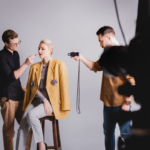A digital watermark is a graphic or text overlay that can be applied to an image file in order to provide copyright information. It also functions as the signature of the photographer, preventing unauthorized use of images.
Watermarks are most commonly placed on two edges at the bottom of an image with one on each side, but can also be added strategically elsewhere depending on how it will appear in print and where it needs to remain unobtrusive.
What is a Watermark?
A watermark is a digital image that overlays the original photo. It is typically done to protect your work from being used without your permission or to add some information for people who may not know where you got the photo. A watermark can be text, an icon, or both and it can be placed at any point on the picture.

They are usually placed in the lower right corner of the picture, but can also be added to any area of the photo. Watermarks are typically used to show ownership and copyright information for digital photographs so they cannot be re-used without permission from the owner.
Why Should You Use a Watermark?
Watermarks are a great way to protect your images from copyright infringement. They can also be used as branding for your photography business and give off an air of professionalism. Even if you don’t sell prints, it’s a good idea to watermark them because they will show up in searches that relate to the event or location where they were taken.
In addition, adding a watermark to your photos can deter people from stealing them. When someone tries to share or use the photo without permission and an image is present with words like “© Your Name” it’s likely they won’t want to take that chance of getting in trouble for copyright infringement.

The following are additional benefits of using a watermark:
- Protects against illegal sharing on social media sites such as Facebook, Twitter, Tumblr, etc. This includes when you repost other websites content (examples include YouTube videos)
- Gives off a professional appearance and air of legitimacy if used correctly
- Prevents others from claiming ownership over images by putting their name on it instead of yours
- It can also be promotional since your watermark is attached to your work and people can trace it back to you, the original owner.
Tips for creating an eye-catching watermark
Keep Your Watermark Simple and Clear
It is important that your watermark doesn’t distract from the original image when it’s added to someone else’s photo. You want people to see this as a way of giving credit for your work, and not something that takes away from it. The first tip is to keep your watermark simple and clear, so that it doesn’t distract from the original image.
Make Sure Your Watermark Isn’t Too Large or Small
The size of your text is very important when you’re trying to create a good user experience. There are two main considerations: the font size and line-height. When you have too large of a font, it can be hard for people with a bad vision to read because they might need glasses or increase their screen brightness.
You also want people who don’t wear glasses to be able to see your website without straining their eyes by holding their phone closer than normal – this will allow them more time on your site! With all that in mind, we recommend using at least 16px as the default font size and 1.5em as the line height. This will allow for a good experience on both mobile and desktop.
You can also use a logo or watermark that doesn’t take up too much space on the image. One way to do this is by using an arrowhead, which is a small geometric shape (often triangular) used in maps and drawings as part of an illustration showing directionality.
For example, if I want my photo with directional information about where it was taken located at the bottom of the photo, then I could place arrows pointing down towards my location stamp so they don’t cover any important details!
Choose a Font that Complements the Style of Your Photos
Choosing the right font for your photos can make a huge difference in how they are perceived. When you’re looking to choose or create a font, it’s important to think about what kind of style you want and then find one that complements it.
If you select an ornate typeface that doesn’t match the mood of your photo, people might not pay attention to the content and instead focus on how off-putting your choice is. This blog post will cover some tips for selecting fonts so that you can pick one that will help draw readers into your story!
Don’t use a font that is too fancy or ornate; think about what kind of mood you’re trying to convey with the photo. If it’s light and airy, try a more understated typeface. If it has a gloomy tone, then select one that matches those feelings. The fonts we choose can create different emotions in people before they even start reading our words!

Always Include an Email Address
When you are taking photos of your work, there is always the goal of getting more customers. That means that you need to have a way for people to contact you and learn about how they can get in touch with more photographers like yourself. In this post, we will discuss three ways that you can provide an email address on your website or blog so that people can find out more information about what services you offer!
First, you can include an email in your “contact us” section of your website. This is a great way to provide contact information for people who are interested in contacting you outside of the blog post that they read! Second, you may want to add a sentence at the bottom of each article asking readers if they have any questions about anything within it.
And lastly, one more option is to put an email address on every photo or video that you upload online with additional information like when and where the photo was taken.

This will allow people to find out exactly what type of photography services you offer based on their needs – whether it be product photos or baby pictures! You might also want to attach social media links so they can follow you on your social media accounts and see if your services fit their needs!
Conclusion
In the end, watermarking is a powerful way to protect your intellectual property rights as an artist/photographer and it’s easier than you might think. If you’re serious about protecting your artwork from being used without permission or copied by someone else, then implementing this simple but effective strategy can be one of the best ways to do so.

































